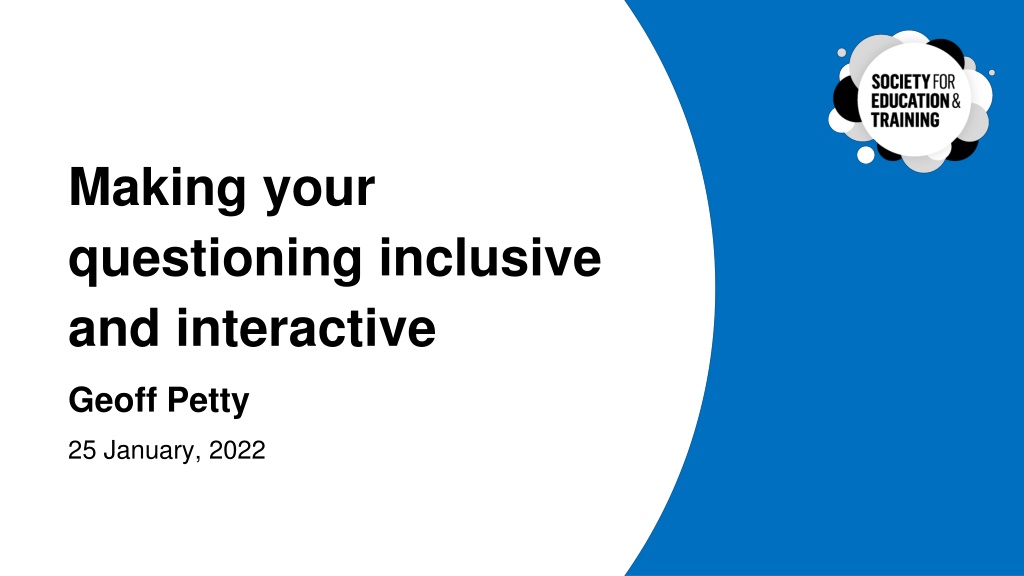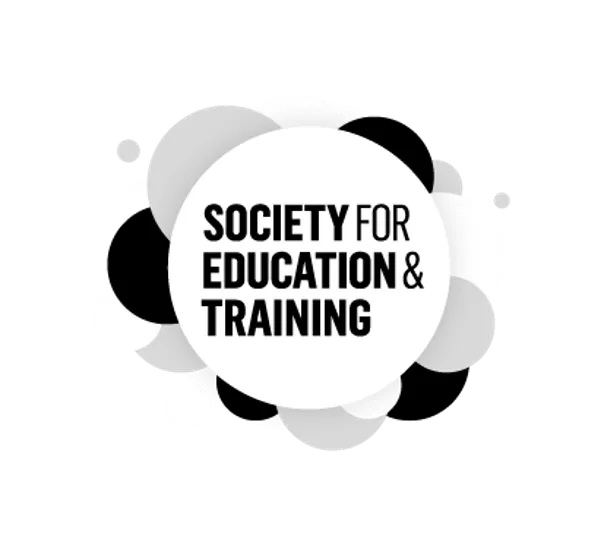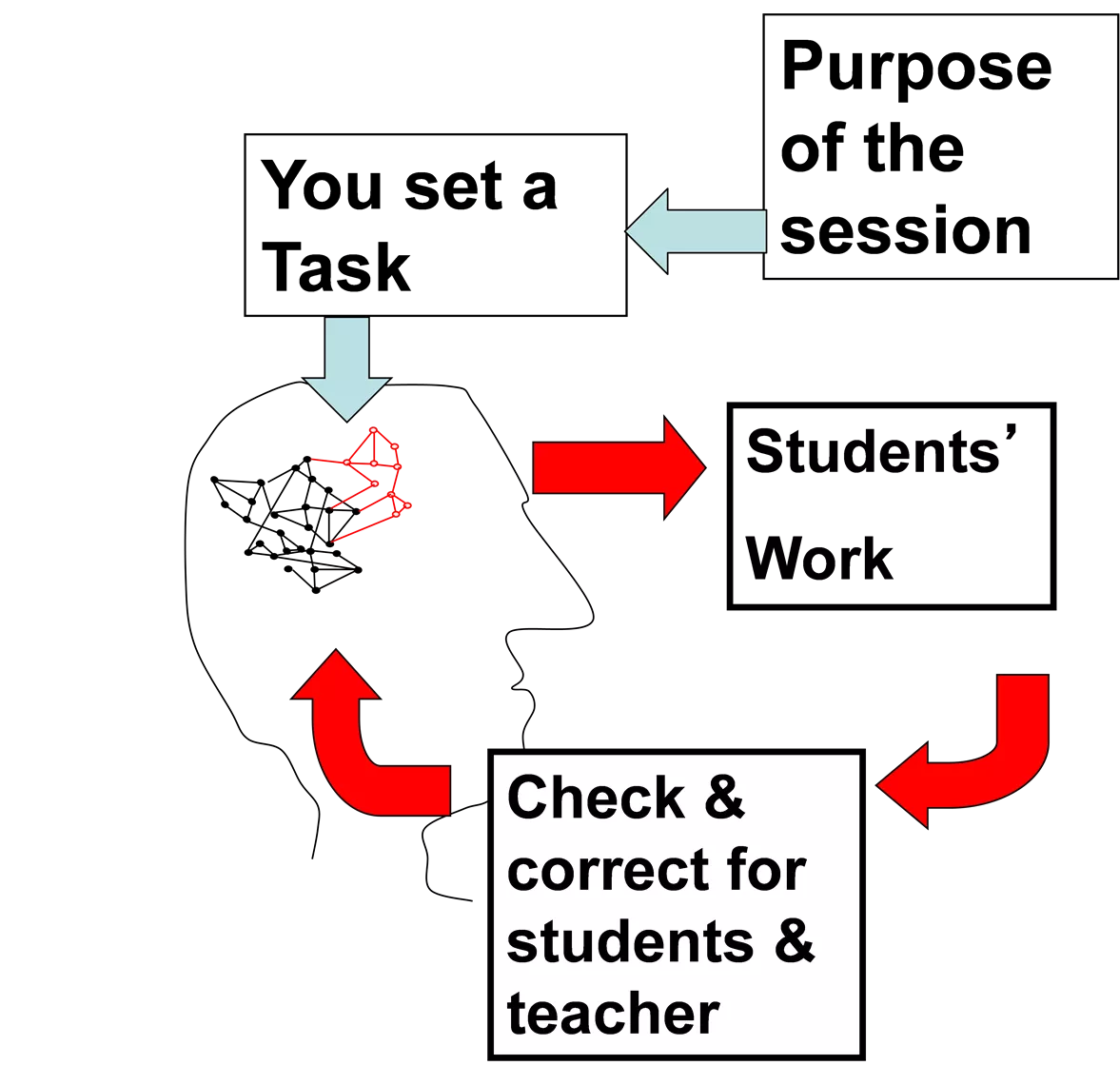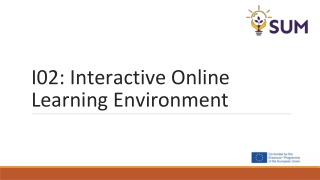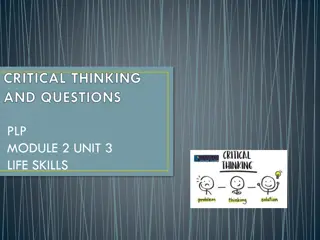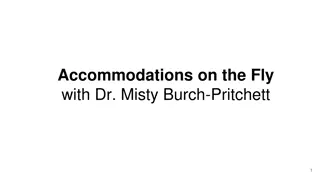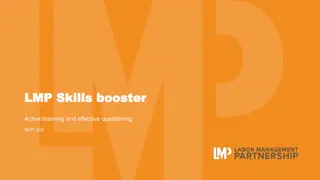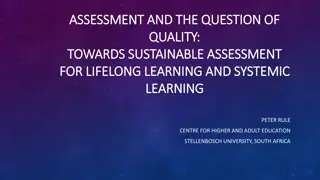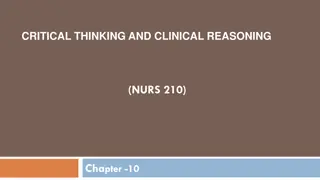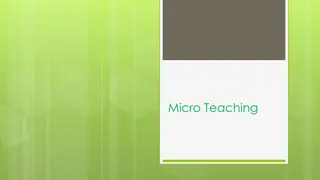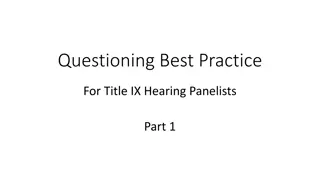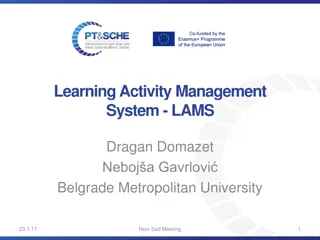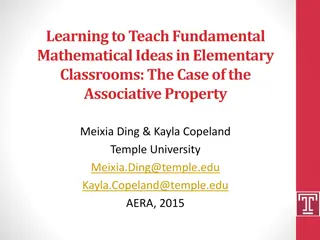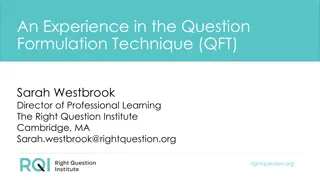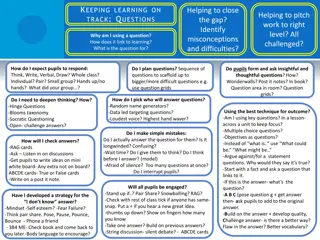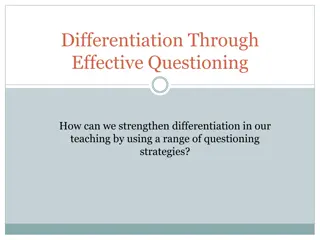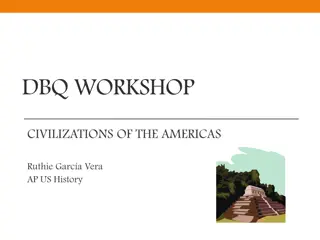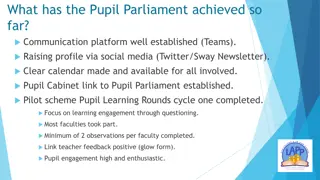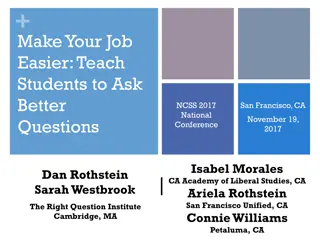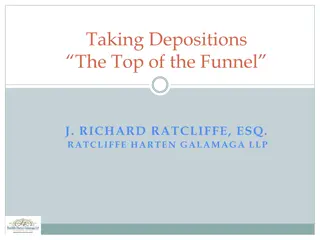Enhancing Questioning Techniques for Interactive Learning
Geoff Petty discusses strategies for making questioning inclusive and interactive in the learning cycle. The content also explores Bloom's Taxonomy levels, including high cognitive demand elements and a fun problem-based learning scenario with the Jabberwocky poem.
Download Presentation

Please find below an Image/Link to download the presentation.
The content on the website is provided AS IS for your information and personal use only. It may not be sold, licensed, or shared on other websites without obtaining consent from the author.If you encounter any issues during the download, it is possible that the publisher has removed the file from their server.
You are allowed to download the files provided on this website for personal or commercial use, subject to the condition that they are used lawfully. All files are the property of their respective owners.
The content on the website is provided AS IS for your information and personal use only. It may not be sold, licensed, or shared on other websites without obtaining consent from the author.
E N D
Presentation Transcript
Making your questioning inclusive and interactive Geoff Petty 25 January, 2022
The Learning Cycle Purpose of the session You set a Task Students Work Check & correct for students & teacher
The Learning Cycle Purpose of the session You set a Task Students Work Check & correct for students & teacher
Bloom s Taxonomy High cognitive demand.. reasoning required Evaluation (give a judgment) Critically appraise, compare and contrast Synthesis (respond creatively) Solve problems, write, design Analysis (consider the parts) Analyse, give reasons Application (do after being shown how) apply, calculate, Comprehension explain, categorise Knowledge state, recall Low cognitive demand.. little reasoning required
Bloom s Taxonomy High cognitive demand.. reasoning required Reasoning so requires: understanding & deep learning Evaluation (give a judgment) Synthesis (respond creatively) Analysis (consider the parts) Application (do after being shown how) Reproducing what you have presented Comprehension Knowledge Low cognitive demand.. little reasoning required
The Jabberwocky Problem Twas brillig, and the slithy toves Did gyre and gimble in the wabe; All mimsy were the borogoves, And the mome raths outgrabe.
The Jabberwocky Problem Twas brillig, and the slithy toves Did gyre and gimble in the wabe; All mimsy were the borogoves, And the mome raths outgrabe. 1. What were the slithy toves doing in the wabe? 2. How would you describe the state of the borogoves? 3. What can you say about the mome raths?
The Jabberwocky Problem 4. Do students need to understand material in order to answer simple questions correctly?
The Jabberwocky Problem Twas brillig, and the slithy toves Did gyre and gimble in the wabe; All mimsy were the borogoves, And the mome raths outgrabe. 5. Why were the borogoves mimsy?
The Jabberwocky Problem Twas brillig, and the slithy toves Did gyre and gimble in the wabe; All mimsy were the borogoves, And the mome raths outgrabe. 5. Why were the borogoves mimsy? 6. How effective was the mome raths strategy?
Place the questions on Blooms Taxonomy: A. What were the slithy toves doing in the wabe? B. How would you describe the state of the borogoves? C. What can you say about the mome raths? D. Why were the borogoves mimsy? E. How effective was the mome raths strategy?
Sum up what the Jabberwocky exercise shows Students need reasoning tasks for deep understanding, and to make their learning useful
An example of a surface learning problem: Research on SATs found that 80% of 12 year olds with calculators could do this: 225 15 = But only 40% can do this: if a gardener has 225 bulbs to place equally in 15 flower beds, how many would be in each bed? Most of the failing pupils did not know which mathematical operation to use. Place these two questions on Bloom s taxonomy.
Bloom s Taxonomy High cognitive demand.. reasoning required Reasoning so requires: understanding & deep learning So gives: functional knowledge & transferable skills Evaluation (give a judgment) Synthesis (respond creatively) Analysis (consider the parts) Application (do after being shown how) Reproducing what teaching has presented So danger of surface learning Comprehension Knowledge Low cognitive demand.. little reasoning required
How to teach for surface learning.. evaluation synthesis analysis division fractions percentages application comprehension Knowledge
Do high order questions need to be difficult? 1. When we make our apple pie tomorrow which of these tools will we need? 2. Which of these knives is best for cutting up apples? 3. How will we make sure we don t cut ourselves? 4. Why must the pastry cover the whole pie? High order questions create transferable learning
Do high order questions need to be difficult? 1. When we make our apple pie tomorrow which of these tools will we need? 2. Which of these knives is best for cutting up apples? 3. How will we make sure we don t cut ourselves? 4. Why must the pastry cover the whole pie? High order questions create transferable learning Exclusive use of low order questions protects students from learning
Level of learner engagement Evaluation Synthesis Analysis Susan Application Comprehension Robert Knowledge Passive low order task set learning activity required Active Constructivist High order task set
Level of learner engagement Evaluation Synthesis Analysis Susan Application Comprehension Robert Knowledge Passive low order task set learning activity required Active Constructivist High order task set
Build a ladder of tasks for each topic Lesson activities Assignments Questioning Worksheets etc Open, Challenging, reasoning tasks Simple reasoning tasks Reproduction tasks
Build a ladder of tasks for each topic Lesson activities Assignments Questioning Worksheets etc Open, Challenging, reasoning tasks Helps with Simple reasoning tasks Helps with Reproduction tasks
POLL For most topics: A. I usually do not set many challenging tasks B. I set a challenging task for about half of topics C. I nearly always set a challenging tasks for each topic D. Nearly all the tasks I set are challenging.
Advance Organiser for this section: How can we make sure every student is thinking when we ask the class a verbal question? How can the teacher get to know, during verbal questioning, which students are understanding the lesson, and which not? Your task: Listen carefully, as this session ends with a quiz.
Volunteers answering is used very commonly worldwide. 1. The teacher asks a question 2. Some students volunteer to answer by putting their hands up 3. The teacher chooses one of these students to answer the question. 4. This student usually gets the answer right 5. The teacher says correct, well done . 6. If a wrong answer is offered, the teacher says no , and corrects the student.
The Learning Cycle Students Work Check & correct for students & teacher
Evaluating volunteers answering teachers verbal questions Cognitive science principles Volunteers answering Participation? Will every student think of an answer? Dialogue? Can students discuss answers in pairs before they respond to the teacher? Does the teacher get representative feedback of class understanding? Do students get enough time to think before the answer is given away?
Evaluating volunteers answering teachers verbal questions Cognitive science principles Volunteers answering Participation? Will every student think of an answer? Dialogue? Can students discuss answers in pairs before they respond to the teacher? Does the teacher get representative feedback of class understanding? Do students get enough time to think before the answer is given away?
Evaluating volunteers answering teachers verbal questions Cognitive science principles Volunteers answering Participation? Will every student think of an answer? Dialogue? Can students discuss answers in pairs before they respond to the teacher? Does the teacher get representative feedback of class understanding? Do students get enough time to think before the answer is given away?
Evaluating volunteers answering teachers verbal questions Cognitive science principles Volunteers answering Participation? Will every student think of an answer? Dialogue? Can students discuss answers in pairs before they respond to the teacher? Does the teacher get representative feedback of class understanding? Do students get enough time to think before the answer is given away?
Evaluating volunteers answering teachers verbal questions Cognitive science principles Volunteers answering Participation? Will every student think of an answer? Dialogue? Can students discuss answers in pairs before they respond to the teacher? Does the teacher get representative feedback of class understanding? Do students get enough time to think before the answer is given away?
How about the teacher distributing questions around the class?
How about the teacher distributing questions around the class? Poor participation even if teachers nominate students to answer: One student answers at a time Students work out it s not my turn and become a passenger. Better if the teacher nominates students (genuinely) randomly. Not representative of class understanding: Most students do not answer a given question, or fully representative of
We need alternative questioning strategies that are Inclusive Interactive
Assertive Questioning ? Ask the question Does anyone need more time? Check for completion Hands up if you don t have an answer Get some answers Thank you Can your answer be improved? Agree a class answer ! Confirmation & praise
Evaluating Assertive Questioning Cognitive science principles Volunteers Answer Assertive Questioning Participation? Will every student think of an answer? Dialogue? Can students discuss answers in pairs before they respond to the teacher? Does the teacher get representative feedback of class understanding? Do students get enough time to think before the answer is given away?
Evaluating Assertive Questioning Cognitive science principles Volunteers Answer Assertive Questioning Participation? Will every student think of an answer? Dialogue? Can students discuss answers in pairs before they respond to the teacher? Does the teacher get representative feedback of class understanding? Do students get enough time to think before the answer is given away?
Evaluating Assertive Questioning Cognitive science principles Volunteers Answer Assertive Questioning Participation? Will every student think of an answer? Dialogue? Can students discuss answers in pairs before they respond to the teacher? Does the teacher get representative feedback of class understanding? Do students get enough time to think before the answer is given away?
Evaluating Assertive Questioning Cognitive science principles Volunteers Answer Assertive Questioning Participation? Will every student think of an answer? Dialogue? Can students discuss answers in pairs before they respond to the teacher? Does the teacher get representative feedback of class understanding? Do students get enough time to think before the answer is given away?
Evaluating Assertive Questioning Cognitive science principles Volunteers Answer Assertive Questioning Participation? Will every student think of an answer? Dialogue? Can students discuss answers in pairs before they respond to the teacher? Does the teacher get representative feedback of class understanding? Do students get enough time to think before the answer is given away?
Mini whiteboards Students have small whiteboards (laminated card) and dry- wipe pens.
Mini whiteboards Students have small whiteboards (laminated card) and dry- wipe pens. 1. The teacher asks a question, and students write their answers. 2. The teacher waits until all or most students have an answer. Students check their neighbours answers. 3. The teacher then asks students to hold their answers up, all at the same time. Students then look round to see what their classmates have written. 4. The teacher surveys all the boards to see what answers were given. 5. The teacher asks Jill, why did you answer 3x ? Something like assertive questioning could follow. 6. The teacher clarifies any misunderstandings.
Evaluating Mini whiteboards Cognitive science principles Volunteers Answer Mini Whiteboards Participation? Will every student think of an answer? Dialogue? Can students discuss answers in pairs before they respond to the teacher? Does the teacher get representative feedback of class understanding? Do students get enough time to think before the answer is given away?
Evaluating Mini whiteboards Cognitive science principles Volunteers Answer Mini Whiteboards Participation? Will every student think of an answer? Dialogue? Can students discuss answers in pairs before they respond to the teacher? Does the teacher get representative feedback of class understanding? Do students get enough time to think before the answer is given away?
POLL Assertive Questioning, mini-whiteboards: A. I could probably make use of one of these strategies B. I could definitely make use of one of these strategies C. I could probably use both of these strategies D. I could definitely use both of these strategies
You need to establish a blame-free classroom: a) It s okay if you don t fully understand a concept first time, learning takes time. b) what counts is whether you understand the question or task, and its answer eventually, not whether you get it right first time c) I ask challenging questions so it is not humiliating to make a mistake. We all make mistakes when we learn. Indeed that is part of how we learn. If we don t make mistakes the work is too easy for us to learn at our maximum rate. d) Mistakes are useful because they tell us how to improve. e) If you make a mistake, often half the class has made it too. f) It s good for learning to say I don t understand and to ask for clarification. g) You should never ridicule another student for their mistakes, even in a joking way because you wouldn t like it if you were ridiculed, and because it stops us learning. h) You will only learn from mistakes if you find out how to do it without mistakes next time, and really understand this.
The No Opt Out Method. Teacher puts What is 3% of 320? on the board: Teacher: What s the first thing we do with this one? W ng.? William: Don t know Teacher: Ch n? Ch n: We need to divide 320 by 100. Teacher: Good, why? Ch n: Because dividing by 100 gets us 1 percent. Teacher: So what s this first thing we do W ng? W ng.: Divide by 100 Teacher: Yes. And why? W ng.: So we know what 1% is. Teacher: Correct.
Doug Lemovs expert teachers said : Because learning is getting it wrong, and then getting it right. There is no shame in not knowing, or getting it wrong, if you learn from it and can answer correctly the next time. Doug Lemov s expert teachers said they used the method so that a student who cannot answer doesn t feel put down. They got it right in the end.
Diagnostic questions: Which statements below are true? (64 possible answers) 1. Area is Length x Height for a rectangle 2. 2 metres squared = 2 metres x 2 metres 3. For a square, area is twice the length of one side 4. Area is measured in the units of length, such as centimetres or metres 5. For a rectangle, the area is always a bigger number, than that for its perimeter 6. Area is the two-dimensional space occupied by a shape, in square units
When trialing any evidence-based teaching method: Trial the method briefly in one of your classes Trial 5 to 25 times Reflect, learn, and decide how to improve Ask your students what they think of the method. Can they think of an improvement you could make? Talk about your trials with colleagues, asking for advice Trial 5 times for does it work and 25 times for quite effective use. (You don t need a control group )
